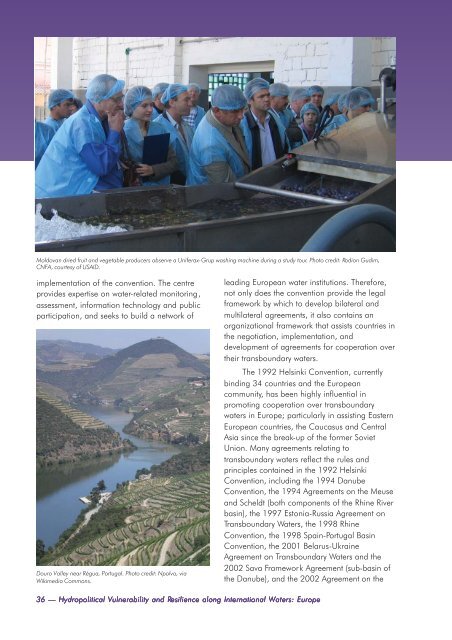Europe - UNEP
Europe - UNEP
Europe - UNEP
You also want an ePaper? Increase the reach of your titles
YUMPU automatically turns print PDFs into web optimized ePapers that Google loves.
Moldovan dried fruit and vegetable producers observe a Uniferax-Grup washing machine during a study tour. Photo credit: Rodion Gudim,<br />
CNFA, courtesy of USAID.<br />
implementation of the convention. The centre<br />
provides expertise on water-related monitoring,<br />
assessment, information technology and public<br />
participation, and seeks to build a network of<br />
Douro Valley near Régua, Portugal. Photo credit: Npolvo, via<br />
Wikimedia Commons.<br />
leading <strong>Europe</strong>an water institutions. Therefore,<br />
not only does the convention provide the legal<br />
framework by which to develop bilateral and<br />
multilateral agreements, it also contains an<br />
organizational framework that assists countries in<br />
the negotiation, implementation, and<br />
development of agreements for cooperation over<br />
their transboundary waters.<br />
The 1992 Helsinki Convention, currently<br />
binding 34 countries and the <strong>Europe</strong>an<br />
community, has been highly influential in<br />
promoting cooperation over transboundary<br />
waters in <strong>Europe</strong>; particularly in assisting Eastern<br />
<strong>Europe</strong>an countries, the Caucasus and Central<br />
Asia since the break-up of the former Soviet<br />
Union. Many agreements relating to<br />
transboundary waters reflect the rules and<br />
principles contained in the 1992 Helsinki<br />
Convention, including the 1994 Danube<br />
Convention, the 1994 Agreements on the Meuse<br />
and Scheldt (both components of the Rhine River<br />
basin), the 1997 Estonia-Russia Agreement on<br />
Transboundary Waters, the 1998 Rhine<br />
Convention, the 1998 Spain-Portugal Basin<br />
Convention, the 2001 Belarus-Ukraine<br />
Agreement on Transboundary Waters and the<br />
2002 Sava Framework Agreement (sub-basin of<br />
the Danube), and the 2002 Agreement on the<br />
36 — Hydropolitical Vulnerability and Resilience along International Waters: <strong>Europe</strong>
















